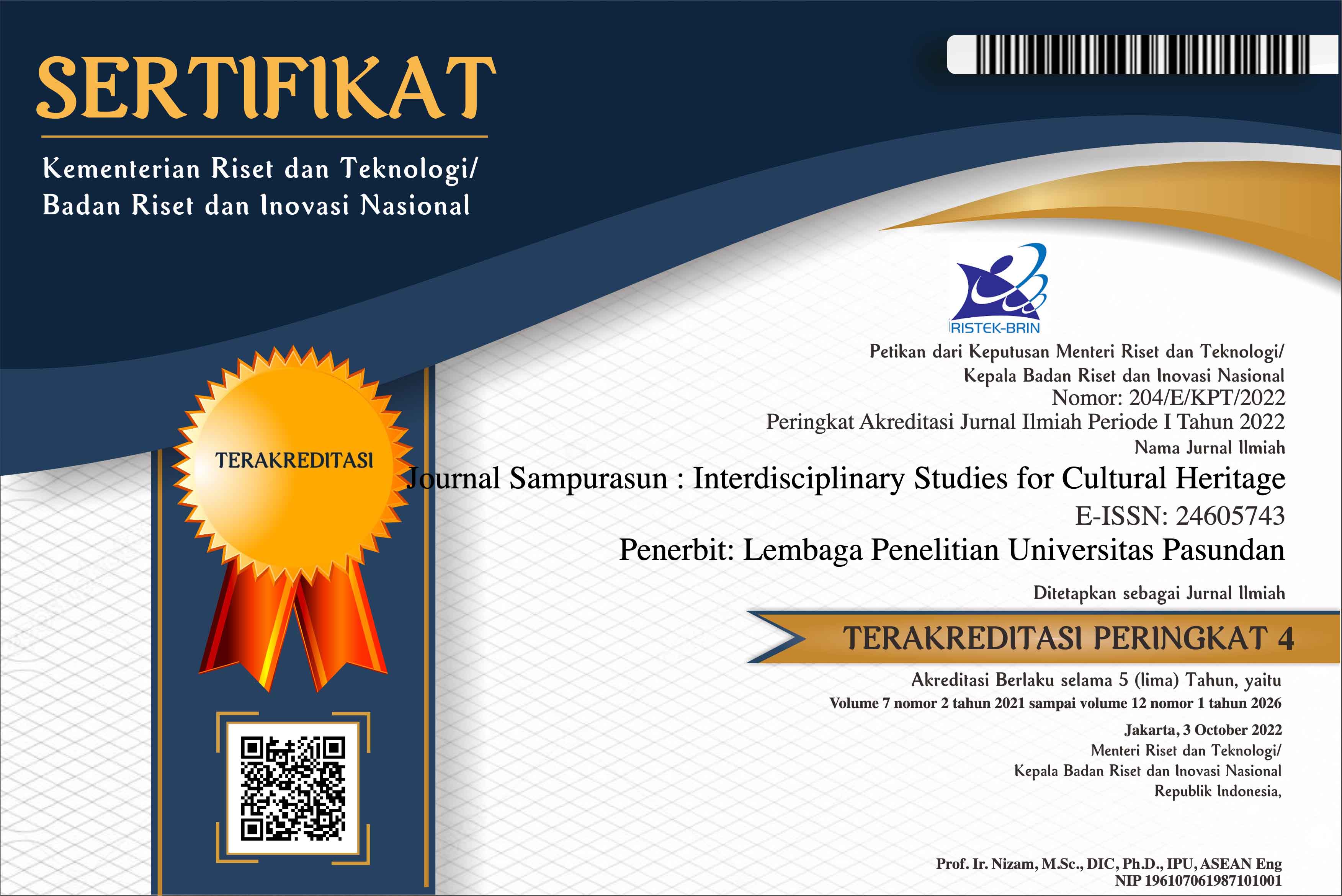Media And Cultural Heritage
DOI:
https://doi.org/10.23969/sampurasun.v1i1.21Abstract
In general, media coverage can have a strong influence on the reputation of a cultural heritage. Media coverage often has an effect on a cultural heritage’s reputation when ‘good’ or ‘bad’ news is reported.This amplifying effect has often been studied through the lens of agenda setting theory. The hypothesis behind the theory is that the frequency with the media report on an issue determines that issues’ salience in the minds of the general public. In other words, the media may not be successful often time in telling people what to think, but it is stunningly successful in telling its readers what to think about. The news media ‘set’ the public agenda.
Since people cannot possibly attend no to every little detail about the cultural heritage around them, setting in communication is important because it helps shape the perspectives through which people see all cultural heritage in the world.In generating good news coverage about a cultural heritage, communicating with the media is one of important activities that should be maintained between communication professionals (in cultural heritage) with journalists.
Keywords: media coverage, agenda setting, framing news
Downloads
References
References
Atre, J., Katz, E. (2005). What’s killing television news? Experimentally assessing the effects of multiple channels on media choice. Paper presented at the International Communication Association Conference, New York, NY.
Bennett, W. L., Iyengar, S. (2008). A new era of minimal effects? The changing foundations of political communication. Journal of Communication, 58(4), 707-731.
Curran, James. (2000). Mass Media and Democracy: A Reappraisal dalam James Curran dan Michael Gurevitch (ed), Mass Media and Society, third edition. London: Arnold Publications.
John Keane, Times Literary Supplement, 28 August 1998, 14-16.
Littlejohn, Stephen W. (2002). Theories of Human Communication, Seventh Edition, Belmont, California: Wardsworth/Thomas Learning.
McQuail, Dennis. (2005). Media Performance: Mass Communication and Public Interest. London: Sage Publications.
Mosco, Vincent. (2009). The Political Economy of Communication, 2nd edition. London: Sage Publications.
Murdoch, Graham. & Golding, Peter. (2000). Political Economy of The Media. London: Routledge.
Neuman, W. R. (1991). The Future of The Mass Audience. New York: Cambridge University Press.
Protess, David L. & Maxwell McCombs. (1991). Agenda Setting: Readings on Media, Public Opinion, and Policymaking. New Jersey: Lawrence Erlbaum Associates, Inc.
Severin, Tankard. & James W. Tankard. (2001). Communication Theories: Origins, Methods and Uses in The Mass Media. New York: Longman.
Stroud, Natalie Jomini. (2008). Media Use and Political Predispositions: Revisiting the Concept of Selective Exposure. Political Behavior, vol. 30, 341–366.
Tuchman, G. (1978). Making News: A Study of The Construction of Reality. New York: Free Press.
Youn, S.M. (1994). Program type preference and program choice in a multichannel situation. Journal of Broadcasting & Electronic Media, 38(4), 465-475.
Downloads
Published
Issue
Section
License
Copyright Notice
Authors should not withdraw their submitted papers because the withdrawal wastes voluntary works devoted by an associate editor and reviewers. But, we accept the withdrawal of a submitted paper if authors have unavoidable reasons. In the event that a manuscript is to be withdrawn from submission to Sampurasun Journal, a letter must be sent to the editorial office requesting withdrawal by e-mail (sampurasunjournal@unpas.ac.id) with its scanned PDF file, before the notification of acceptance for publication.
The withdraw request letter must include the following information. Paper ID, Paper title, Authors names, Reason why the paper must be withdrawn, and Date and signatures of all the authors (or signature of the contact author).
If only the contact author signs the letter, he/she must obtain the agreement of the withdrawal from all the other authors and the letter must include the description that all the other authors agreed the withdrawal. The journal will not withdraw a manuscript from peer review until such a letter has been received. Authors must not assume their manuscript has been withdrawn until they have received appropriate notification from the editorial office. Withdrawal of a manuscript subsequent to acceptance for publication will only be granted in the most exceptional of circumstances.
After the paper is accepted for publication, the withdrawal is not permitted in principle. The authors must always pay the charge even if the withdrawal is permitted. Any request of withdrawal that does not follow the above procedure is treated as invalid. If illegal submission, e.g., plagiarized or duplicate submission, is found for a paper, the withdrawal of the paper will never be permitted and the authors will be punished based on the rule. It is not acceptable practice to withdraw a manuscript in the event of acceptance at another journal. This constitutes dual submission. The editorial office of the other journal will be notified of your actions. In such circumstances Sampurasun ISCH may chose to impose appropriate punitive action subject.
Withdrawal Penalty
Author is not allowed to withdraw submitted manuscripts, because the withdrawal is waste of valuable resources that editors and referees spent a great deal of time processing submitted manuscript, money and works invested by the publisher. If author still requests withdrawal of his/her manuscript when the manuscript is still in the peer-reviewing process, author will be punished with paying $200 per manuscript, as withdrawal penalty to the publisher. However, it is unethical to withdraw a submitted manuscript from one journal if accepted by another journal. The withdrawal of manuscript after the manuscript is accepted for publication, author will be punished by paying US$500 per manuscript. Withdrawal of manuscript is only allowed after withdrawal penalty has been fully paid to the Publisher. If author don't agree to pay the penalty, the author and his/her affiliation will be blacklisted for publication in this journal. Even, his/her previously published articles will be removed from our online system.


















